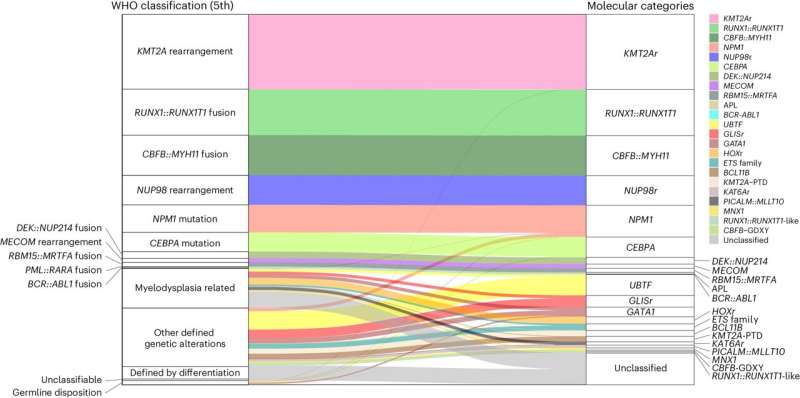This article has been reviewed according to Science X's editorial process and policies. Editors have highlighted the following attributes while ensuring the content's credibility:
fact-checked
peer-reviewed publication
trusted source
proofread
Updated genomic landscape for pediatric acute myeloid leukemia enables new treatment possibilities

Compared to adult cancers, pediatric cancers often have distinctive genetic causes. This means there is an opportunity to develop pediatric-focused diagnostic strategies and treatments. Research by St. Jude Children's Research Hospital published today (Jan. 11) in Nature Genetics clarifies the genomic landscape of pediatric acute myeloid leukemia (pAML). The work offers novel insight into this cancer's causes and unique biological characteristics.
The findings establish 23 distinct molecular categories (including 12 categories not covered by the current classification systems) that can be used to classify cases of pAML on an individual basis. This marks a vital step towards understanding the molecular background and improving treatment strategies in the future. The classification of these cancers and appreciation of their uniqueness is not just a helpful tool for doctors to diagnose patients more accurately. It is also critical to identify the most effective therapeutic route and to ultimately save lives.
Identifying the blind spot
Just over 4 per every 100,000 people develop AML yearly; the vast majority are adults. This conceals the effect of pediatric cases, which account for about 500 new cases each year. Due to this, a disparity in how we understand this cancer has grown. "Most of what we know about classifications of AML really comes from the adult field," said Jeffery Klco, MD, Ph.D., St. Jude Department of Pathology. "AML is more common in adults than it is in children."
Klco, along with first authors Masayuki Umeda, MD, Ph.D., and Jing Ma, Ph.D., first demonstrated the unique features of pAML in 2022 with the discovery of a novel alteration in the UBTF gene.
"That put forth a new entity in pediatric AML that had not been described before," explained Klco. "We decided to take a deeper dive into the overall classification of pediatric AML, recognizing that there are very significant differences between AML in adults and kids."
To do this, they amassed a cohort of 887 unique pAML cases and examined what was driving the cancers through transcriptome and gene profiling.
"A lot of the types of AML that we see here at St. Jude, you just don't see in adults," Klco emphasized.
AML classification provides biological insight and potential clinical guidance
The reasons why different features give rise to AML in children and adults have yet to be fully understood. The normal accumulation of mutations during aging may explain many adult AML cases. In contrast, fusion oncoproteins, aberrant proteins resulting in the fusion of two separate genes, are major drivers for many pAML cases and were shown to account for more than 70% of cases in this new study.
Although each molecular category has a unique driver, some show very similar transcriptional and mutational profiles, which stood out to the researchers. "Some categories show very similar transcriptional profiles, indicating that the background biology is similar and can be potentially treated by similar drugs," said Umeda.
This work offers a clear path forward for clinicians to identify distinct pAML sub-types and for larger collaborative groups to define cancer more accurately. "The World Health Organization [WHO] issued new classifications for hematological cancers in 2022, mostly based on adults," Klco explained. "We recognized that many of the recurrent alterations we found in pAML aren't even mentioned. Some of these sub-types have a significant impact on outcomes."
Correct classification will allow clinicians worldwide to understand their pAML patients better and offer guidance to treat cases as low-risk or high-risk. In fact, through their analysis, they determined a strong association between the new sub-types and clinical outcomes. "The study definitely fills a lot of gaps in the current classification of pAML," Ma confirmed. "It provides a risk stratification strategy that we hope will provide clinicians with a simpler road to accurate diagnosis and optimal treatment in the future."
More information: Masayuki Umeda et al, A new genomic framework to categorize pediatric acute myeloid leukemia, Nature Genetics (2024). DOI: 10.1038/s41588-023-01640-3



















